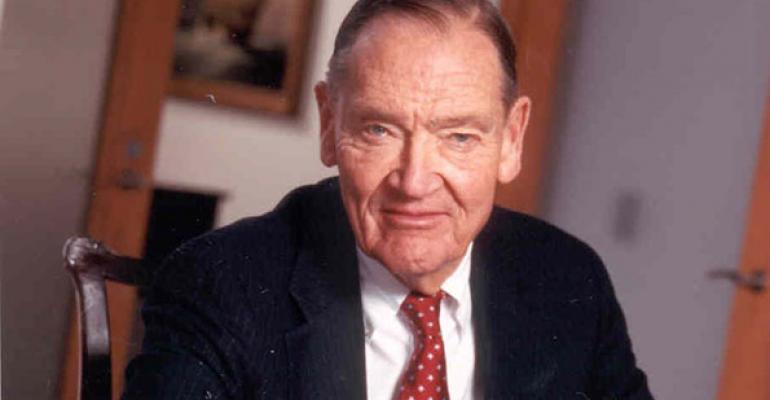With the passing of Vanguard founder Jack Bogle on Wednesday, many farewells and memories are being shared in the financial community from those who knew him or met him in their professional lives. CFRA certainly shares in the heartfelt sentiment for this founding father of index investing. Moreover, we think it is imperative to understand the asset management world today—one that has been so influenced by Bogle’s vision, even as so much has changed in the 42 years since Bogle and Vanguard introduced the first index mutual fund Vanguard 500 Index Fund (VFINX) for individual investors.
Coincidentally, the day after Bogle died, Morningstar published its year-end flows and assets recap highlighting the ongoing shift away from active management toward passive. In 2018, investors added approximately $460 billion to so-called passive index mutual funds and ETFs, while removing more than $300 billion from actively managed funds. If the move to passive investing continues at the same furious pace as in recent years, the total assets under management in U.S. equity passive index funds (currently at $3.6 trillion) will outpace AUM in active funds (currently at $3.8 trillion) by the end of 2019.
CFRA thinks the launch of four zero fee mutual funds in the second half of 2018, including Fidelity Zero Large Cap Index Fund (FNILX), could help further catapult passive funds amid the growing demand for low-cost strategies. But 40 years ago, it likely would have seemed impossible to believe that the firm behind then-manager Peter Lynch’s Fidelity Magellan Fund (FMAGX) would aggressively compete based on price for passively managed assets.
Meanwhile, for years, investors seeking taxable bond fund exposure relied more on active management. At the end of 2018, actively managed taxable bond funds had more than double the assets ($2.6 trillion) of passive rivals ($1.2 trillion). However, cracks in the active management veneer are emerging. In December, investors pulled $44 billion from these active funds amid increased bond market volatility, yet investors added $1.3 billion into passive bond funds that month. CFRA thinks as investors better understand they lost money in most active bond funds in 2018, those investors will do further research on cheaper alternatives.
Bogle retired from Vanguard in 1999; in the years since, the asset management giant has continued to gather assets. Indeed, the firm’s recent $2.4 trillion in index mutual fund assets, approximately $900 billion in index ETFs and roughly $900 billion in actively managed mutual funds, highlights the breadth of its asset base.
Let’s further focus on ETFs since that’s where the competition to “out-Vanguard” Vanguard seems to be most visible. Vanguard’s ETF market share of 26 percent, second behind just iShares, expanded slightly in 2018, despite increased competition. In 2018, Vanguard S&P 500 (VOO), Vanguard Total Stock Market (VTI) and Vanguard FTSE Developed Markets (VEA) were the firm’s three most popular products based on inflows, consistent with the firm’s original focus of providing cheap, well-diversified strategies for potential buy-and-hold usage.
CFRA has research on 83 Vanguard ETFs and all but two of them have expense ratios less than 0.25 percent—yet Vanguard often does not offer the cheapest ETF in an investment style.
For example, Vanguard FTSE Emerging Markets ETF (VWO) charges a modest 0.14 percent fee that is in line with iShares Core MSCI Emerging Markets (IEMG) but is undercut by Schwab Emerging Markets Equity ETF (SCHE) and SPDR Portfolio Emerging Markets (SPEM).
While SSGA and Schwab are the third- and fifth-largest ETF asset managers in the U.S. and have a long-established passively managed ETF presence, the emergence of traditional active management firms into the passive world would have been even more surprising 20 years ago.
Franklin Growth Fund (FKGRX) launched in 1948, many years before Bogle brought the first index fund to market. The firm launched its first ETF index in 2013 and has since broadened its lineup to 39 ETFs, including index-based Franklin LibertyQ US Equity ETF (FLQL), which charges a 0.25 percent expense ratio, well below the 0.87 percent for FKGRX.
Meanwhile, Goldman Sachs Capital Growth Fund (GSCGX) launched in 1990 and is still actively managed by an experienced team. Just over three years ago, Goldman further caused fee compression in the smart-beta ETF space by offering Goldman Sachs ActiveBeta US Large Cap Equity (GSLC), a quant-based index offering for an expense ratio of just 0.09 percent.
Todd Rosenbluth is the director of ETF and mutual fund research at CFRA. Learn more about CFRA's ETF research here.





